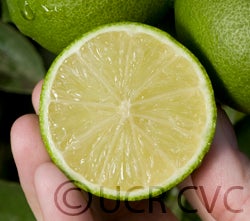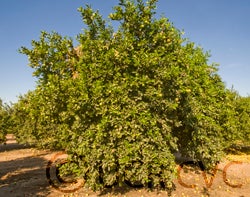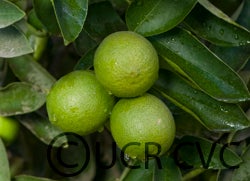Citrus latifolia (Yu. Tanaka) Tanaka
CRC 391
PI 539273
Source
Received as budwood from Mr. Hart's grove, San Dimas, Ca, 1914
Parentage/origins
Parents unknown.
Rootstocks of accession
Yuma Ponderosa lemon
Season of ripeness at Riverside
Somewhat everbearing, mainly in winter (earlier in hot climates such as southern Florida).
Notes and observations
1985, EMN: The tree from which buds were taken was in full bearing and was one of an acre of limes. Buds cut by Mertz, Barrett, and Milliken.
Description from The Citrus Industry Vol. 1 (1967)
"Fruit medium-small (like small lemon), oval, obovate, oblong or short-elliptical; base usually rounded but sometimes slight necked and faintly furrowed; apex rounded; areolar area elevated into a low nipple. Seeds are or lacking. Rind thin; surface smooth, tightly adherent; color pale lemon-yellow at maturity. Segments about 10; axis small and usually solid. Flesh color pale greenish-yellow; tender, juicy; very acid and with true lime flavor. Somewhat everbearing, mainly in winter (earlier in hot climates such as southern Florida). If left on tree past maturity, some fruits develop a peculiar breakdown in the areolar area at the stylar end.
Tree vigorous, broad-spreading, drooping, medium to medium-large, nearly thornless; foliage dense green. Leaves medium in size, broadly lanceolate, and petioles winged. Flower buds and flowers medium in size and flowering occurs throughout year, mainly in spring. Purple coloration usually faint and evanescent in both flowers and shoots. Fully as cold-resistant as the true lemons.
The origin of the Tahiti or Persian lime is unknown, and its history is obscure. The name Tahiti arises from the fact that this type of lime was introduced in California from Tahiti sometime during the period of 1850 to 1880. As the Persian lime, it was introduced into Australia as early as 1824 (Bowman, 1955), possibly from Brazil, since it is mentioned in connection with the Celeta (Seleta) and Bahia orange varieties of that country. The origin of the name Persian is unknown, however, although it seems likely that this fruit came to the Mediterranean area via Persia as did the citron. Currently, it is not to be found in Persia, however (Chapot, 1965b). The Sakhesli lime of the island of Djerba (Tunisia) is clearly of the same type and has been grown there for a long time, presumably centuries. H. Chapot, the distinguished French citrus systematist, reports that he has also seen old trees of this fruit in Algeria and that the name Sakhesli means "from Sakhos," an Arabic name for the island of Chios (Greece).
While the only commercial variety of the Tahiti lime apparently produces no viable pollen and is normally seedless, Reece and Childs (1962) succeeded in obtaining 250 seeds from a commercial canning plant in Florida from which 140 seedlings were planted in an orchard and 77 survived and ultimately fruited. A high degree of monoembryony is indicated as only two seedlings proved to be indistinguishable from the parent clone. The remaining seedlings exhibited a very wide range in species characters, but approximately 60 per cent were predominantly citron, lemon, or seedy acid lime. From these data, Reece and Childs concluded that this lime is clearly of hybrid origin, that one parent is obviously the common acid lime, and that the other is either lemon or citron, but probably the latter. It is interesting that they were unable to observe more than 18 chromosomes, the normal diploid number for the genus, whereas Bacchi (1940) reported this lime as triploid in genetic constitution.
While further study will be required to make certain of the facts, it appears that there are presently several horticultural clones of Tahiti or Persian lime, only one of which is commercially important."
Availability
Not commercially available in California.
USDA Germplasm Resources Information Network page for Tahiti lime


